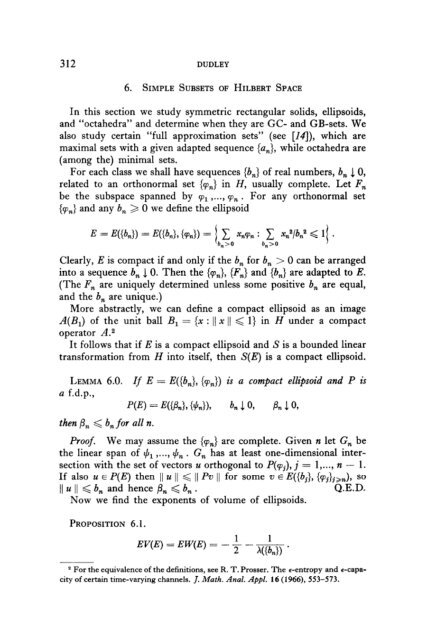On the Characters and the Plancherel Formula of Nilpotent Groups ...
On the Characters and the Plancherel Formula of Nilpotent Groups ...
On the Characters and the Plancherel Formula of Nilpotent Groups ...
Create successful ePaper yourself
Turn your PDF publications into a flip-book with our unique Google optimized e-Paper software.
312 DUDLEY<br />
6. SIMPLE SUBSETS OF HILBERT SPACE<br />
In this section we study symmetric rectangular solids, ellipsoids,<br />
<strong>and</strong> “octahedra” <strong>and</strong> determine when <strong>the</strong>y are GC- <strong>and</strong> GB-sets. We<br />
also study certain “full approximation sets” (see [14]), which are<br />
maximal sets with a given adapted sequence {un}, while octahedra are<br />
(among <strong>the</strong>) minimal sets.<br />
For each class we shall have sequences {b,} <strong>of</strong> real numbers, b, JO,<br />
related to an orthonormal set {vn> in H, usually complete. Let F,<br />
be <strong>the</strong> subspace spanned by vi ,..., qn. For any orthonormal set<br />
{qn} <strong>and</strong> any b, 2 0 we define <strong>the</strong> ellipsoid<br />
Clearly, E is compact if <strong>and</strong> only if <strong>the</strong> b, for b, > 0 can be arranged<br />
into a sequence b, JO. Then <strong>the</strong> {F~}, {F,) <strong>and</strong> {bn} are adapted to E.<br />
(The F, are uniquely determined unless some positive b, are equal,<br />
<strong>and</strong> <strong>the</strong> b, are unique.)<br />
More abstractly, we can define a compact ellipsoid as an image<br />
A(&) <strong>of</strong> <strong>the</strong> unit ball B, = {X : 11 x 11 < l> in H under a compact<br />
operator A2<br />
It follows that if E is a compact ellipsoid <strong>and</strong> S is a bounded linear<br />
transformation from H into itself, <strong>the</strong>n S(E) is a compact ellipsoid.<br />
LEMMA 6.0. If E = E({b,), {c&) is a compact ellipsoid <strong>and</strong> P is<br />
a f.d.p.,<br />
P(E) = WQ, GM), bn 10, fin 109<br />
<strong>the</strong>n /3, < b, for all n.<br />
Pro<strong>of</strong>. We may assume <strong>the</strong> {q,} are complete. Given n let G, be<br />
<strong>the</strong> linear span <strong>of</strong> #r ,..., #, . G, has at least one-dimensional intersection<br />
with <strong>the</strong> set <strong>of</strong> vectors u orthogonal to P(yJ, j = l,..., n - 1.<br />
If also u E P(E) <strong>the</strong>n 11 u 11 < 11 Pv I/ for some v E E({b,}, {q~~}~&, so<br />
11 u II < b, <strong>and</strong> hence p, < b, . Q.E.D.<br />
Now we find <strong>the</strong> exponents <strong>of</strong> volume <strong>of</strong> ellipsoids.<br />
PROPOSITION 6.1.<br />
EV(E) = EW(E) = - ; - & .<br />
2 For <strong>the</strong> equivalence <strong>of</strong> <strong>the</strong> definitions, see R. T. Prosser. The r-entropy <strong>and</strong> e-capa-<br />
city <strong>of</strong> certain time-varying channels. J. Math. Anal. Appl. 16 (1966), 553-573.

















